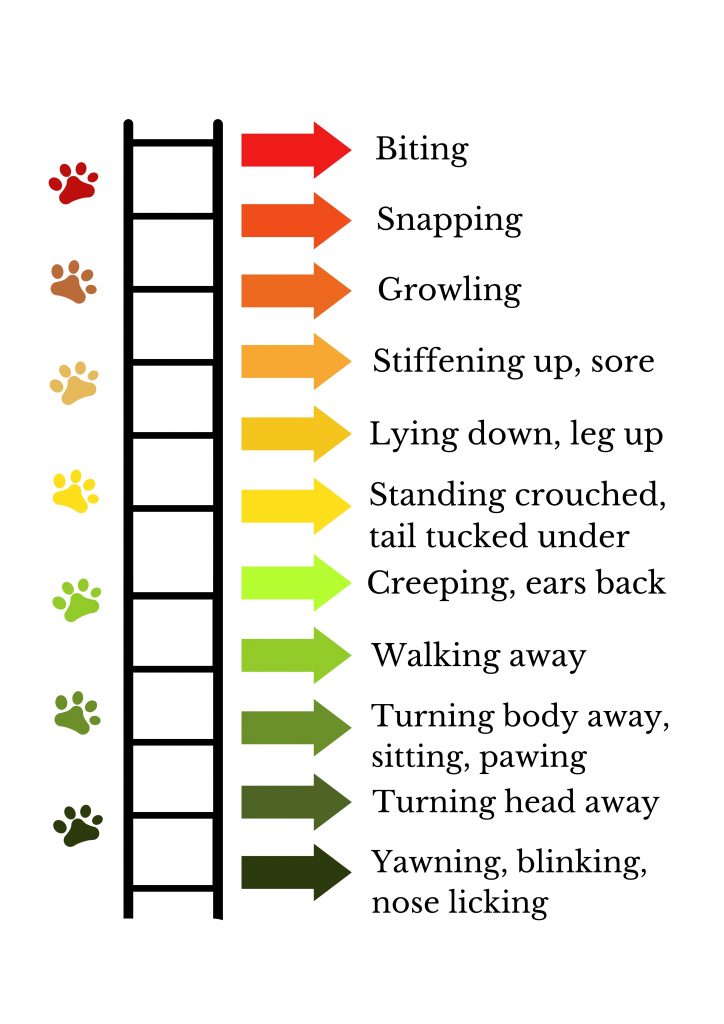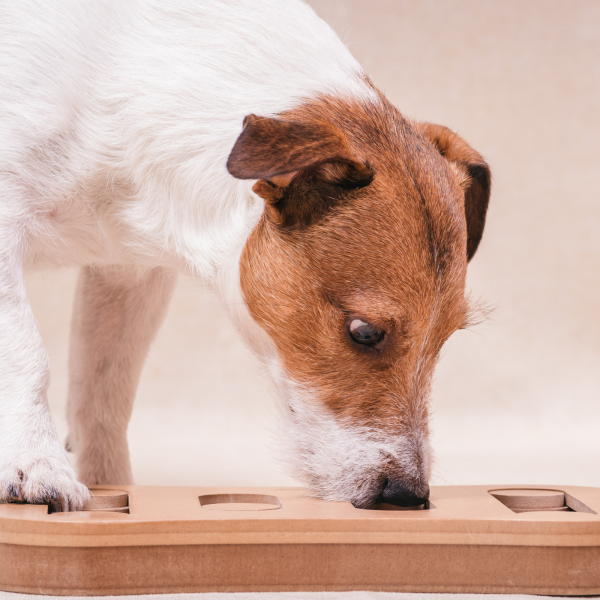Understanding Dog Anxiety
Dogs try to tell us in so many ways when they are uncomfortable about a situation. This may be different depending on the individual and each dog will have an individual threshold for how much they will tolerate depending on genetics, upbringing, and previous experience. Behaviour that shows a dog is scared or anxious are called ‘Appeasement Behaviours’.
Appeasement Behaviours include paw lift, lip lick, whale eye and rolling on their back. Take note of the tail as well. Although a waggy tail typically means a happy dog, dogs who are reacting or about to bite the tail may also have a wagging tail!
Causes
Two common causes of anxiety in dogs are; Fear and Separation. Fear-related anxiety can be caused by several factors such as loud noises, medication, surroundings (such as the vet’s) or visual stimuli (such as hats). Separation anxiety is when the dog struggles to find comfort when they are left alone.
Symptoms
Kendal Shepard devised a helpful tool called “The Ladder of Aggression”. It is a good illustration of behaviours which dogs usually display in response to a threat.
If the signals at the bottom, such as lip licking, and yawning are not listened to and do not work then the dog slowly works up the ladder, ending in biting to different degrees. Some dogs take a long time to work up the ladder whereas others escalate quickly. Dogs, like people all, have different thresholds, and that can change on a day-to-day basis depending on what else has happened previously.

- Yawning can be a sign that a dog is tired, but it also signals stress
- Lip licking or tongue flicking. Dogs lick their lips when nervous
- Brief body freezing – the dog is still for a few seconds before reacting
- Body freezing – the dog freezes until the threat goes away or he decides to use fight or flight
- ‘Whale Eye’ – the dog turns his head away but keeps looking at the perceived threat, showing the whites of his eyes
- Head turn – the dog will turn his head away from a fear source as a gesture of appeasement
- Furrowed brow, curved eyebrows – caused by facial tension
- Tense jaw – the mouth is closed, and the dog is preparing for action
- Hugging – a dog will gain comfort by holding onto his owner
- Low tail carriage – indicates discomfort and uncertainty
- Curved tongue – the tongue is curved at the edges from tension
- Raspy, dry-sounding panting – nervousness reduces saliva production
- Twitching whiskers – caused by facial tension
- Shaking – caused by adrenaline release
- Drooling – stress can also cause excessive salivation
- Lack of focus – an anxious dog finds learning difficult
- Sweaty paws – dogs sweat through their foot pads
- Piloerection – the hair on a dog’s neck and spine stands on end (like human goose bumps), making the dog appear bigger while releasing odour from the glands contained in the dog’s hair follicles
Treatment
The best way to treat your dog’s anxiety is to identify what is causing your dog to be anxious or scared and either remove it, move your dog away or stop what is causing the fear. It is important that we take the pressure off.
Once your dog is in a calm and relaxed state, behaviour rehabilitation will be far more effective.
Contacting a professional dog trainer to help you choose the best approach is the best first step to treating your dog’s anxiety.
Ready to take the first step? Click here or email info@caninekin.co.uk to book an Initial consultation where I will get to know your dog, understand their needs and map out the best journey for your dog’s anxiety-free life!
Understanding Dog Anxiety
Dogs try to tell us in so many ways when they are uncomfortable about a situation. This may be different depending on the individual and each dog will have an individual threshold for how much they will tolerate depending on genetics, upbringing, and previous experience. Behaviour that shows a dog is scared or anxious are called ‘Appeasement Behaviours’.
Appeasement Behaviours include paw lift, lip lick, whale eye and rolling on their back. Take note of the tail as well. Although a waggy tail typically means a happy dog, dogs who are reacting or about to bite the tail may also have a wagging tail!
Causes
Two common causes of anxiety in dogs are; Fear and Separation. Fear-related anxiety can be caused by several factors such as loud noises, medication, surroundings (such as the vet’s) or visual stimuli (such as hats). Separation anxiety is when the dog struggles to find comfort when they are left alone.
Symptoms
Kendal Shepard devised a helpful tool called “The Ladder of Aggression”. It is a good illustration of behaviours which dogs usually display in response to a threat.
If the signals at the bottom, such as lip licking, and yawning are not listened to and do not work then the dog slowly works up the ladder, ending in biting to different degrees. Some dogs take a long time to work up the ladder whereas others escalate quickly. Dogs, like people all, have different thresholds, and that can change on a day-to-day basis depending on what else has happened previously.

- Yawning can be a sign that a dog is tired, but it also signals stress
- Lip licking or tongue flicking. Dogs lick their lips when nervous
- Brief body freezing – the dog is still for a few seconds before reacting
- Body freezing – the dog freezes until the threat goes away or he decides to use fight or flight
- ‘Whale Eye’ – the dog turns his head away but keeps looking at the perceived threat, showing the whites of his eyes
- Head turn – the dog will turn his head away from a fear source as a gesture of appeasement
- Furrowed brow, curved eyebrows – caused by facial tension
- Tense jaw – the mouth is closed, and the dog is preparing for action
- Hugging – a dog will gain comfort by holding onto his owner
- Low tail carriage – indicates discomfort and uncertainty
- Curved tongue – the tongue is curved at the edges from tension
- Raspy, dry-sounding panting – nervousness reduces saliva production
- Twitching whiskers – caused by facial tension
- Shaking – caused by adrenaline release
- Drooling – stress can also cause excessive salivation
- Lack of focus – an anxious dog finds learning difficult
- Sweaty paws – dogs sweat through their foot pads
- Piloerection – the hair on a dog’s neck and spine stands on end (like human goose bumps), making the dog appear bigger while releasing odour from the glands contained in the dog’s hair follicles
Treatment
The best way to treat your dog’s anxiety is to identify what is causing your dog to be anxious or scared and either remove it, move your dog away or stop what is causing the fear. It is important that we take the pressure off.
Once your dog is in a calm and relaxed state, behaviour rehabilitation will be far more effective.
Contacting a professional dog trainer to help you choose the best approach is the best first step to treating your dog’s anxiety.
Ready to take the first step? Click here or email info@caninekin.co.uk to book an Initial consultation where I will get to know your dog, understand their needs and map out the best journey for your dog’s anxiety-free life!



